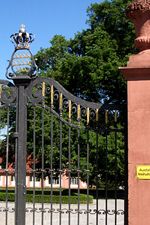When we look back at development in Sacramento, we may remember this as the era when the region shrank from the public sphere. The latest American Housing Survey reports that secured communities now constitute 90,000 households in the region. This figure consists with the nationwide explosion of private communities in recent decades, and may only mark the beginning of privatized modes of living.
Self-reliance for security and services may be attractive for the communities that can afford it, but it risks leaving behind those less affluent.
Sacramento’s secured communities are a glaring example. These communities have gates or walls to keep non-residents out, and often employ private security forces. They line the boulevards of Granite Bay and Fair Oaks, or may be tucked away like Rancho Murieta, a quiet upscale enclave along Highway 16.
These communities effectively shrink the public sphere, restricting traffic, pedestrian movement and green space by consuming large swaths of land. Access often requires exorbitant fees to private community associations that perform functions ranging from road maintenance and grounds-keeping to cable television and country clubs.
Scholars cite crime as a primary reason for the growth of private communities. Whether due to reality or perception, 58,000 households in the region report inadequate police protection, which suggests a large potential market for more privately guarded communities. Recent upward trends in violent crime in Sacramento will only further demand.
Yet many social scientists point out the lack of concrete evidence that private communities make their residents any safer. What is certain is that they have serious drawbacks, at least for the excluded. The growth of private communities threatens to divide a region considered one of the most integrated in the nation along racial and class lines.
Because community associations provide many of their own services that city government otherwise would, fewer citizens have a stake in public infrastructure. Granted, even the most exclusive communities still play their part by serving as reliable tax bases—that is, until they incorporate and hoard more of their tax revenues for themselves, leaving public institutions such as school systems in the lurch. Right now, a small number of newly incorporated towns are pushing that envelope. If the trend grows, total privatization of government functions could conceivably become the next phase in privatized living.
CH2M Hill, a for-profit firm with specialties ranging from nuclear cleanup to water projects, has a division that offers near complete local government services. While established cities have cooled on outsourcing in recent years, newly incorporated cities have been CH2M Hill’s bread and butter. In Sandy Springs, Ga., the firm handles nearly all functions of city hall except emergency services. Since signing with CH2M Hill, the city directly employs only five people; everyone else is a contractor.
At the forefront of the contracting boom, CH2M Hill has contracts in Iraq, New Orleans and post-tsunami projects in Asia. Despite controversy over some of this contracting work (the Department of Energy fined it $400,000 for worker safety slip-ups), its municipal governance division is growing: besides Sandy Springs, three more Georgia cities have signed on. CH2M Hill has also reportedly conducted talks in the Sacramento region, probably eyeing the wave of newly incorporated cities.
As a growing midsize region, the Sacramento area is at a crossroads. Either it can build on existing efforts to foster an open community with mixed cultures and incomes, or it can turn inward toward exclusive modes of living. If we choose the latter, what CH2M Hill calls the “Sandy Springs model” could be the next fault line between the privileged and excluded.
-Josh Leon








